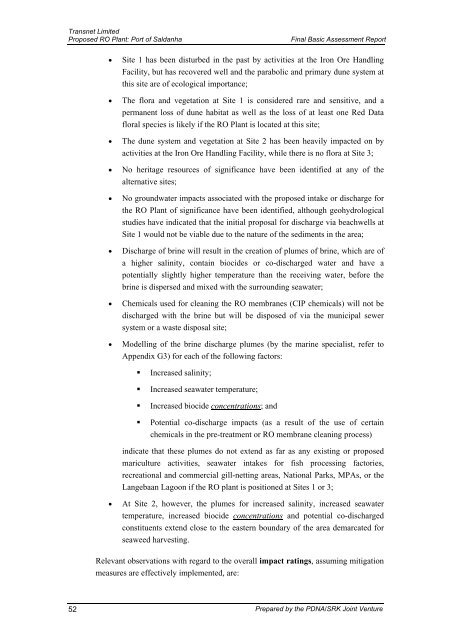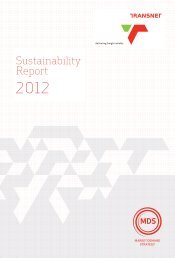Basic Assessment Report - Transnet
Basic Assessment Report - Transnet
Basic Assessment Report - Transnet
Create successful ePaper yourself
Turn your PDF publications into a flip-book with our unique Google optimized e-Paper software.
<strong>Transnet</strong> LimitedProposed RO Plant: Port of SaldanhaFinal <strong>Basic</strong> <strong>Assessment</strong> <strong>Report</strong>• Site 1 has been disturbed in the past by activities at the Iron Ore HandlingFacility, but has recovered well and the parabolic and primary dune system atthis site are of ecological importance;• The flora and vegetation at Site 1 is considered rare and sensitive, and apermanent loss of dune habitat as well as the loss of at least one Red Datafloral species is likely if the RO Plant is located at this site;• The dune system and vegetation at Site 2 has been heavily impacted on byactivities at the Iron Ore Handling Facility, while there is no flora at Site 3;• No heritage resources of significance have been identified at any of thealternative sites;• No groundwater impacts associated with the proposed intake or discharge forthe RO Plant of significance have been identified, although geohydrologicalstudies have indicated that the initial proposal for discharge via beachwells atSite 1 would not be viable due to the nature of the sediments in the area;• Discharge of brine will result in the creation of plumes of brine, which are ofa higher salinity, contain biocides or co-discharged water and have apotentially slightly higher temperature than the receiving water, before thebrine is dispersed and mixed with the surrounding seawater;• Chemicals used for cleaning the RO membranes (CIP chemicals) will not bedischarged with the brine but will be disposed of via the municipal sewersystem or a waste disposal site;• Modelling of the brine discharge plumes (by the marine specialist, refer toAppendix G3) for each of the following factors:• Increased salinity;• Increased seawater temperature;• Increased biocide concentrations; and• Potential co-discharge impacts (as a result of the use of certainchemicals in the pre-treatment or RO membrane cleaning process)indicate that these plumes do not extend as far as any existing or proposedmariculture activities, seawater intakes for fish processing factories,recreational and commercial gill-netting areas, National Parks, MPAs, or theLangebaan Lagoon if the RO plant is positioned at Sites 1 or 3;• At Site 2, however, the plumes for increased salinity, increased seawatertemperature, increased biocide concentrations and potential co-dischargedconstituents extend close to the eastern boundary of the area demarcated forseaweed harvesting.Relevant observations with regard to the overall impact ratings, assuming mitigationmeasures are effectively implemented, are:52Prepared by the PDNA/SRK Joint Venture
















